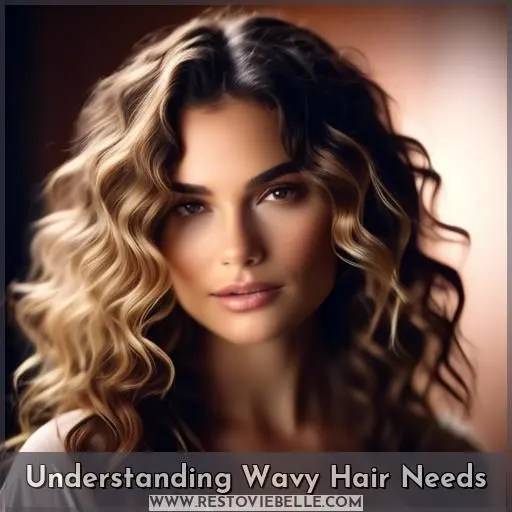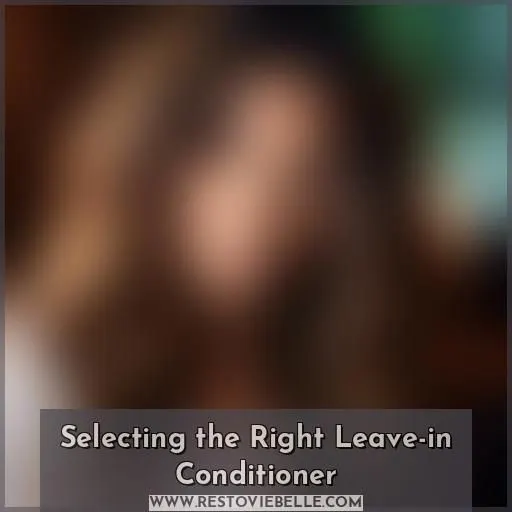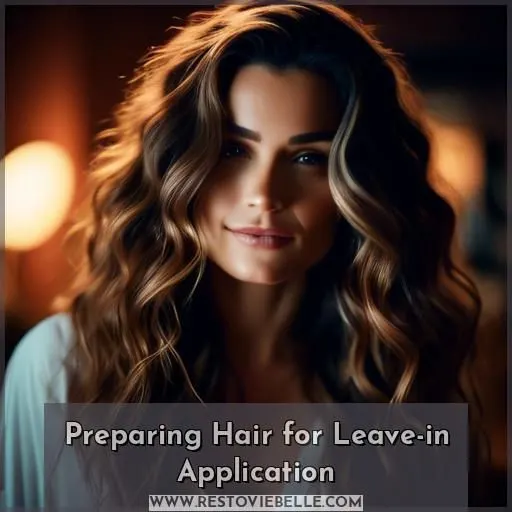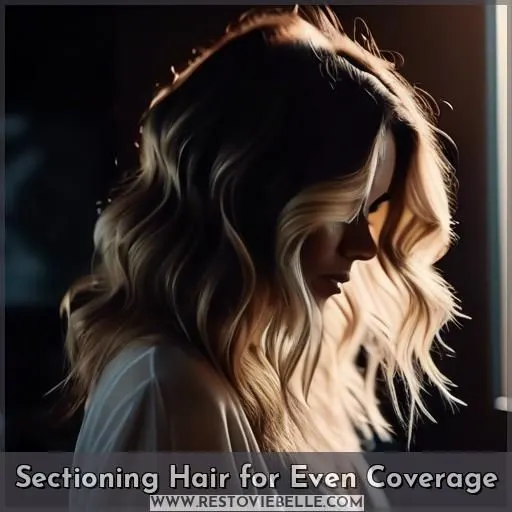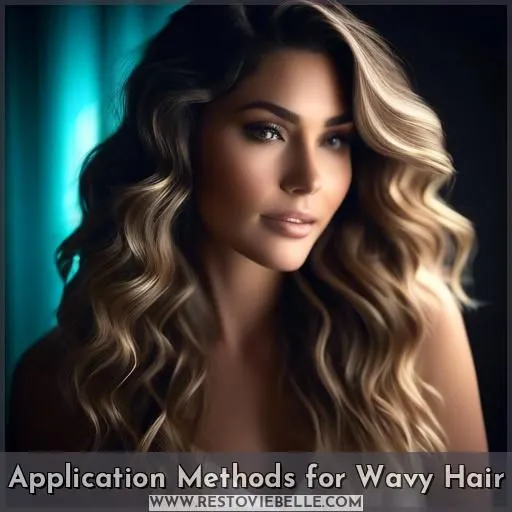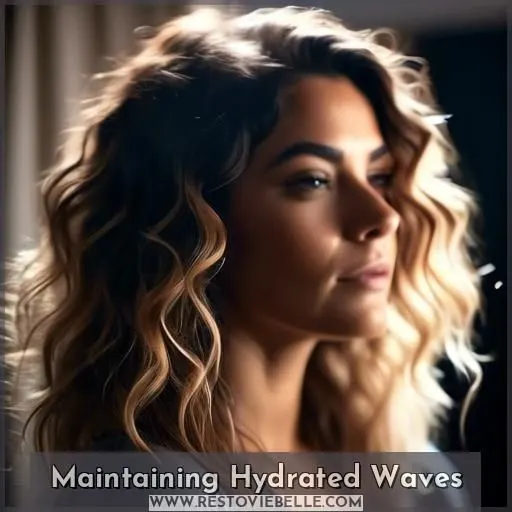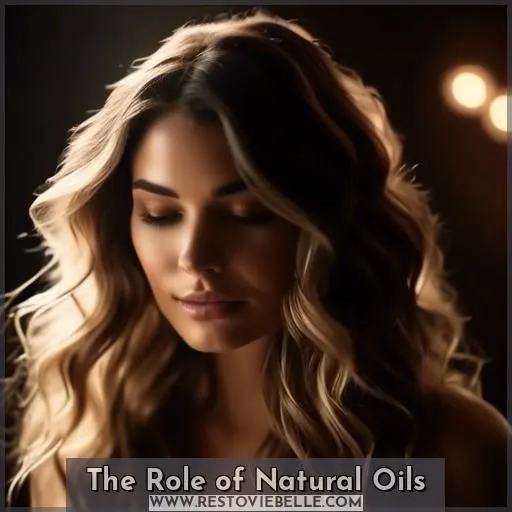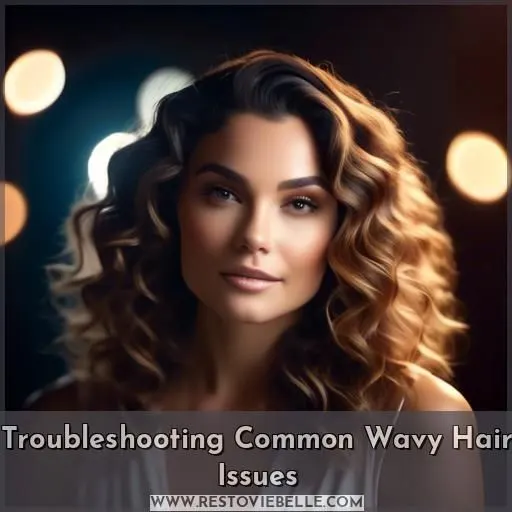This site is supported by our readers. We may earn a commission, at no cost to you, if you purchase through links.
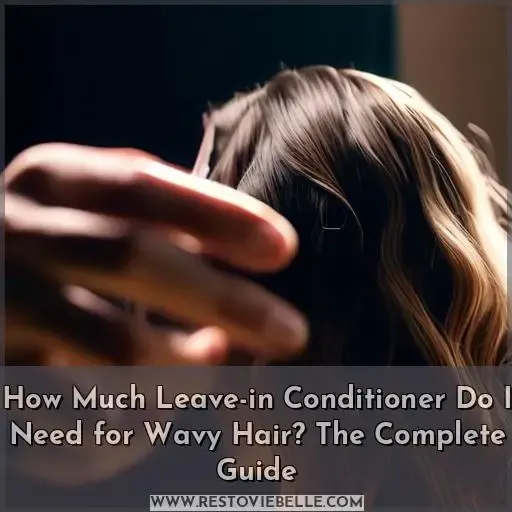
You’ll need to evaluate your hair’s density, porosity, and length when deciding how much leave-in conditioner for wavy hair to use.
As a general guideline, use a quarter-sized amount for shorter waves and up to a few palmfuls for longer, thicker hair.
Highly porous strands may need more product to offset moisture loss. However, avoid overdoing it to prevent weighed-down or limp waves.
Begin with a small amount, focusing on midlengths and ends, then gradually increase until you achieve the desired hydration and hold.
But that’s just the start – let’s explore further into customizing your leave-in routine for enviable, defined waves.
Table Of Contents
- Key Takeaways
- How Much Leave in Conditioner Do I Need for Wavy Hair?
- Understanding Wavy Hair Needs
- Selecting the Right Leave-in Conditioner
- Preparing Hair for Leave-in Application
- Sectioning Hair for Even Coverage
- Determining Leave-in Quantity
- Application Methods for Wavy Hair
- Styling After Leave-in Treatment
- Maintaining Hydrated Waves
- The Role of Natural Oils
- Troubleshooting Common Wavy Hair Issues
- Frequently Asked Questions (FAQs)
- Conclusion
Key Takeaways
- Evaluate hair density, porosity, and length to determine the appropriate amount of leave-in conditioner for wavy hair.
- Balance moisture and volume by selecting a lightweight, volumizing leave-in conditioner that provides hydration without weighing down hair.
- Understand your wave type, as this will dictate the ideal consistency and quantity of leave-in conditioner needed to nourish your tresses without compromising their resilient, voluminous texture.
- Choose a leave-in conditioner with natural oils like jojoba or coconut, which excel at retaining moisture and are suitable for wavy hair.
How Much Leave in Conditioner Do I Need for Wavy Hair?
For wavy hair, the amount of leave-in conditioner needed can vary depending on the individual’s hair type, texture, and personal preferences. However, as a general guideline, start with a small amount, such as the size of a dime or a quarter, and work your way up as needed. It’s essential to apply the conditioner to damp hair and avoid applying it to sopping wet hair, as it will just rinse off. It’s also recommended to use a wide-toothed comb to ensure even distribution and avoid unwanted build-up. If you feel that not all strands have been covered, use more; if you have excess product, use less. Remember, less is often more, especially for long hair.
Understanding Wavy Hair Needs
Wavy hair necessitates a delicate equilibrium between hydration and volume; while curls crave moisture, excessive conditioning can potentially burden your waves and reduce their natural buoyancy. Determining your specific wave pattern is paramount, as this will dictate the ideal consistency and quantity of leave-in conditioner required to nourish your tresses without compromising their resilient, voluminous texture.
Balancing Moisture and Volume
Essential for wavy hair is the balancing of moisture and volume.
Porosity, protein balance, hair length, and styling preferences all play a part in determining the quantity of leave-in conditioner that’s needed.
Layering products can aid in achieving the ideal equilibrium between hydration and hold.
Experiment with various leave-in conditioners to find the one most suitable for your wavy hair, ensuring a healthy, balanced appearance.
Identifying Your Wave Type
To make an informed choice regarding the ideal leave-in conditioner for your wavy hair, it’s imperative to gain an understanding of your wave type. Wavy hair can be categorized into distinct types based on its texture, density, and porosity levels. These factors play a pivotal role in determining the optimal leave-in conditioner for your hair.
Texture: Wavy hair can range from fine to coarse, with varying thickness and resilience. Fine hair is more prone to breakage and may necessitate lighter formulas, while coarse hair is more resistant to heat, chemicals, and styling.
Density: Hair density refers to the number of strands per square inch of scalp. Hair with high density appears full or voluminous, while hair with low density may lack volume and require more product for even distribution.
Porosity: Porosity is the hair’s capacity to absorb hydration. High porosity hair rapidly absorbs moisture but may lose it quickly, while low porosity hair retains moisture well but may require more effort to penetrate the hair shaft.
Curl Pattern: Wavy hair can have varying curl patterns, from loose waves to tighter spirals. Understanding your curl pattern will assist you in choosing a leave-in conditioner that provides the appropriate balance of hydration and definition for your hair.
Scalp Sensitivity: Some individuals may have sensitive scalps that react to certain ingredients in leave-in conditioners. It’s essential to choose a product that’s gentle and suitable for your scalp type.
Selecting the Right Leave-in Conditioner
When selecting a leave-in conditioner for wavy hair, look for ingredients that provide hydration without weighing your hair down, such as humectants like glycerin, botanical oils, and lightweight silicones. Choose a formula labeled as weightless, volumizing, or mist to make sure your waves maintain their bounce and body while receiving essential moisture.
Ingredients for Hydration
After understanding your wavy hair’s unique needs, it’s time to immerse yourself in the hydration sanctuary. Selecting the ideal leave-in conditioner is akin to choosing your foremost hydration protector.
- Seek out natural oils such as jojoba or coconut, which excel at retaining moisture.
- Ascertain your hair porosity; it determines the degree of hydration your locks require.
- Product texture should correspond with your wave type; not all heroes are ostentatious, but they do customize their strategy!
Weightless Formulas for Bounce
To achieve bouncy, well-defined curls with wavy hair, you should consider using a lightweight leave-in conditioner. These formulas are designed to provide hydration and moisture without weighing down your hair, which is essential for maintaining volume and preventing frizz. When selecting a leave-in conditioner, look for products that contain natural oils like jojoba, coconut, shea, and aloe leaf extract, as they can help lock in moisture and nourish your hair.
To apply the leave-in conditioner, follow these steps:
- After washing and towel-drying your hair, section it into small sections to make sure it’s covered evenly.
- Apply a small amount of leave-in conditioner to your hair, starting from the ends and working your way up to the roots.
- Avoid applying the product directly to your scalp to prevent excess buildup.
- If you have thick, long, or high-porosity hair, you may need to use more product to achieve the desired results.
Remember to let your hair air dry naturally after applying the leave-in conditioner to allow it to work its magic. If you prefer to use heat styling tools, make sure to use a heat protectant first to prevent damage.
Preparing Hair for Leave-in Application
For best leave-in conditioner absorption, you’ll need to start with freshly washed, thoroughly cleansed hair. After shampooing, gently towel-dry your waves by blotting—don’t rub vigorously, as this can cause frizz and disrupt the curl pattern.
Importance of a Clean Base
Before using leave-in conditioner, make sure your hair is clean and free of buildup.
Begin with a pre-shampoo treatment to clarify and deeply cleanse your scalp. This step is essential for curly and wavy hair, as these hair types tend to accumulate product.
Additionally, avoid using thick conditioners that can weigh down your hair. A lightweight leave-in conditioner is ideal for wavy hair, as it provides hydration without weighing it down.
Towel-Drying Techniques
Regarding towel-drying your hair before using a leave-in conditioner, preventing uneven application and possible damage is vital. These techniques can facilitate this:
- Lightly Squeeze: After washing, gently remove excess moisture. Refrain from rubbing your hair with the towel, as this can create friction and lead to breakage.
- Divide Hair: Separate your hair into smaller sections, particularly for hair with tight textures, coils, or loose curls. This promotes even distribution when applying the leave-in conditioner.
- Employ a Microfiber Towel: Microfiber towels are advisable for drying hair because they generate less friction and are milder on your hair compared to standard towels.
- Avoid Excessive Drying: Don’t dry your hair completely with the towel. Leave it slightly moist to allow the leave-in conditioner to absorb into the hair.
- Reapply If Necessary: If your hair remains wet after towel-drying, you may need to reapply the leave-in conditioner to ensure adequate coverage.
Sectioning Hair for Even Coverage
Sectioning hair for even coverage is essential when applying leave-in conditioner to wavy hair. This technique guarantees that every strand receives an equal amount of product, promoting hydration and nourishment. Here’s how to do it:
- Towel-dry hair: After washing, gently towel-dry your hair to remove excess water. This makes it easier to apply the leave-in conditioner equitably.
- Section your hair: Use your fingers or a wide-tooth comb to separate your hair into small sections. For loose curls, you may want to clip or tie back sections to keep them manageable. For coily hair, use the PATTERN Hair Pick or Edge Tool to create smaller sections.
- Apply evenly: Once your hair is sectioned, use a quarter-sized amount of leave-in conditioner and work it through each section from scalp to end. If you have thick, long, or high-porosity hair, you may need more product.
- Comb through: After applying the leave-in conditioner, gently comb your hair using a wide-tooth comb to guarantee even distribution. This helps prevent tangles and ensures that the product is uniformly distributed.
- Style as usual: Once your hair is sectioned and treated with leave-in conditioner, you can style it as usual. This may include air drying, using heat protectant and blow-drying, or applying a holding gel for added definition and hold.
Determining Leave-in Quantity
Determining the optimal amount of leave-in conditioner for your wavy hair is a subjective matter.
Imagine your hair as a sponge; its absorbency determines its thirstiness.
Highly porous hair eagerly absorbs more product, while low porosity hair accepts it gradually.
Consider your hair length and climate, and you’ll have a formula tailored to your needs.
A small amount, comparable to a pea, may be sufficient for shorter waves.
Longer locks might require a quarter-sized portion or more.
Bear in mind, it’s more manageable to add than remove.
Begin with a modest amount and gradually increase it until you achieve the desired hold without overburdening your curls.
This approach allows your waves to maintain their buoyancy and keeps your hair care routine adaptable, responding to the needs of your hair and the fluctuations of the weather.
Application Methods for Wavy Hair
When applying leave-in conditioner to wavy hair, you have two main options: spraying or using a cream formula. Sprays provide lightweight, even coverage, while creams offer richer hydration; however, cream products should be focused on the mid-lengths and ends to avoid weighing down your roots.
Spraying Vs. Cream Application
Regarding the application of leave-in conditioner to wavy hair, the selection between spray and cream application techniques hinges upon your hair’s nature and desired outcomes.
For delicate waves, a light spray can ensure uniform distribution.
While coarse waves might thrive on a creamier formula for enhanced hydration.
Loose waves can utilize either method.
But tighter waves may necessitate a larger quantity of product for thorough coverage.
Adhere to the guidance provided with your hair care products.
And modify the amount of leave-in conditioner as required for your wavy hair.
Avoiding the Scalp
When applying leave-in conditioner to your wavy hair, it’s essential to steer clear of the scalp area. This is because scalp oils, buildup, and sensitivity can trigger irritation, dryness, or even frizz in your waves. Instead, concentrate on applying the leave-in conditioner to the ends of your hair, where it requires the most hydration. For tighter-textured hair, you may want to apply the leave-in to smaller sections to guarantee even coverage.
If you have a dry scalp, you can still use leave-in conditioner, but be sure to choose a product that’s specifically designed for scalp care. Look for leave-ins that don’t leave behind scalp buildup, contain moisturizers and oils for lasting hydration, and are formulated without ingredients that could be harmful to the scalp. Some leave-ins may also contain scalp soothing medicinals like aloe vera and peppermint to further benefit your scalp.
When applying the leave-in conditioner, start by spraying or spreading it on a small section of your scalp and wait at least 48 hours to observe how your scalp will react. If your scalp shows no sign of irritation, you can apply the leave-in throughout your scalp, making sure to part your hair all over to guarantee coverage. Don’t overdo it, as this increases the likelihood of buildup.
Styling After Leave-in Treatment
After applying your leave-in conditioner, you have two styling options: air drying or heat styling.
For air drying, gently scrunch your waves with your hands or an old cotton t-shirt to enhance definition and remove excess moisture.
If heat styling, apply a small amount of holding product like a mousse or cream. Diffuse or blow-dry your waves upside down. Then gently break the cast when completely dry.
Air Drying Vs. Heat Styling
With regard to styling your wavy hair post leave-in conditioner application, you have two primary choices: air drying or blow drying.
For air drying, utilize diffusion techniques to permit your curls to dry naturally and sustain their form.
Curl enhancing products can be applied prior to air drying to augment definition.
Conversely, you can blow dry your hair using a diffuser attachment and heat protectant to minimize harm and sustain your wavy hair regimen.
Ultimately, the selection between air drying and heat styling is contingent upon your personal preference and hair wellness objectives.
Enhancing Wave Definition
In terms of elevating wave definition post-leave-in conditioner application, the crucial step is to allow your curls to dry naturally in the open air.
This permits the moisture absorption to work its wonders, bestowing your waves with a hydrated radiance.
Should you desire a swifter drying process, you may employ a heat protectant and blow-dry your hair.
Bear in mind, the objective is to preserve curl definition while mitigating frizz and avoiding damage.
By utilizing the appropriate leave-in conditioner, you can attain awe-inspiring, luscious, and buoyant waves that defy gravity and retain their form until your next washing occasion.
Maintaining Hydrated Waves
Maintaining hydrated waves is essential for wavy hair health.
Leave-in conditioners offer numerous benefits, including hydration, repair, and protection.
To guarantee your wavy hair stays moisturized, select a product with natural oils like jojoba, coconut, shea, aloe leaf extract, and tea tree oil. These oils aid in retaining moisture, providing extra hydration for parched curls.
When applying leave-in conditioner, use a quarter-sized amount and distribute it from ends to roots, avoiding the scalp. You can also use more product for thick, long, or highly porous hair.
By maintaining hydration with the appropriate product selection and application techniques, you’ll enjoy smoother, more defined curls with a hydrated glow.
The Role of Natural Oils
Regarding the selection of a leave-in conditioner for your hair, natural oils such as jojoba, coconut, shea, and aloe leaf extract can be remarkably advantageous. These oils aid in the retention of moisture, offering increased hydration for dehydrated curls and damaged hair. They can also enhance elasticity, diminish friction, and amplify shine, making your hair more manageable and style-friendly.
Jojoba oil, specifically, is an excellent choice for curly hair. It can penetrate deeply into the hair follicles, moisturizing from within and reducing frizziness. It also harmonizes the scalp, assisting in maintaining a healthy hair equilibrium. Coconut oil, another widely used natural oil, penetrates deeply into the hair shaft, providing essential moisture and minimizing protein loss. It can also enhance curl definition and safeguard against damage.
When utilizing a leave-in conditioner, it’s paramount to apply it uniformly and comprehensively from the scalp to the ends. Commence with a modest amount and work it through your hair, adding more as necessary. Refrain from applying the conditioner directly to the scalp, as this can lead to accumulation and weigh down your hair.
Troubleshooting Common Wavy Hair Issues
You’ll want to strike a balance with the amount of leave-in conditioner you use to prevent frizz while avoiding a weighed-down look. Too little product won’t properly coat and smooth the hair cuticle, allowing frizz to form, but an excess can make waves appear limp and undefined.
Dealing With Frizz
After diving into the wonders of natural oils, let’s tackle that pesky frizz. It’s like the uninvited guest at your hair party, right? With the right leave-in application, you’re not just inviting moisture to stay; you’re giving frizz the boot. Think of your leave-in conditioner as the bouncer, keeping your waves’ volume in check while ensuring the moisture balance is just right.
| Step | Purpose | Tip |
|---|---|---|
| 1. Choose | Selecting the right product | Go for leave-ins rich in natural oils. |
| 2. Section | Ensuring even coverage | Divide hair to avoid missed spots. |
| 3. Apply | Moisture without the mess | Use a dime-sized amount per section. |
| 4. Style | Locking in the look | Pair with styling products that complement. |
| 5. Dry | Preserving volume | Air dry or diffuse for best results. |
Preventing Weighed-Down Waves
Preventing weighed-down waves is essential for maintaining the bounce and definition of your wavy hair. Here are three hair care tricks to help you achieve this:
- Use Humectants Thoughtfully: Humectants attract moisture, but too much can weigh down your waves. Opt for lightweight humectants like aloe vera or glycerin.
- Avoid Silicones: Silicones can build up on your hair, weighing it down. Choose leave-in conditioners with natural oils instead.
- Clarify Periodically: Clarifying periodically with a non-silicone shampoo helps remove buildup, leaving your waves lighter and more bouncy.
Frequently Asked Questions (FAQs)
Can leave-in conditioner replace mousse?
You can replace mousse with leave-in conditioner, but they’ve different purposes. Mousse adds volume and hold, while leave-in conditioner hydrates and detangles – giving you soft, manageable waves.
Does hard water affect leave-in efficacy?
Indeed, hard water can hinder the effectiveness of leave-in conditioners. The mineral buildup acts as a barrier, reducing the product’s ability to penetrate and nourish strands effectively. Consider investing in a water softener or purifying rinses to guarantee your hair receives the ultimate care it deserves.
Is leave-in conditioner safe for kids?
You bet! Leave-in conditioners are perfectly safe for kids’ hair. In fact, they’re great for keeping little ones’ locks soft, manageable, and tangle-free. Just use a pea-sized amount and gently work it through damp hair – their curls will thank you!
How does leave-in conditioner impact dye?
Leave-in conditioner can impact hair dye by sealing in color and preventing premature fading. However, it’s best to use a color-protecting formula to avoid buildup that dulls vibrancy. For touchups, apply conditioner from mid-lengths to ends to preserve new growth’s intensity.
Can leave-in conditioner cause scalp issues?
Like a protective shield, leave-in conditioner can cause scalp buildup if used excessively. However, when applied sparingly to the mid-lengths and ends, it hydrates strands without clogging pores. Moderation is key for a healthy, flake-free scalp.
Conclusion
Determining the optimal leave-in conditioner quantity** for your wavy hair necessitates experimentation.
Evaluate varying amounts and monitor how your curls respond in terms of moisture, definition, and controllability.
By customizing the application to your hair’s distinct porosity and thickness, you’ll attain beautifully hydrated, frizz-free waves that exhibit their full potential.
Perfecting the technique of using the appropriate quantity of leave-in conditioner for wavy hair is crucial to achieving desirable, lasting results.

